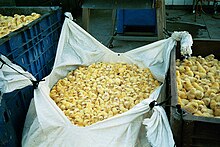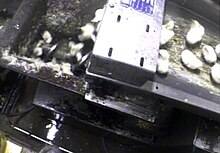宰殺雛鳥
宰殺雛鳥是指畜牧業者在禽鳥剛孵化不久就因不符所需性別而將雛鳥宰殺的做法,常見於雞蛋生產過程,因為公雞不能下蛋,且蛋雞經過品種培育後作為肉雞飼養的效益過低[1]。除了不能下蛋的公雞,還有病弱的母雞,以及肝醬用的鵝和鴨中肝臟成長率較差的雌性也會被剔除。此做法不論是籠飼、放養、或有機飼養的業者都廣泛使用,只有極少數業者避免此行為[2][3]。每年全世界有約七十億隻公雞以及四千萬隻母鴨被如此宰殺。[4][5][6]



常見的宰殺方法包括直接以機器絞碎及二氧化碳窒息。由於絞碎的時間最快,在西方國家認為是較人道的做法,也是最常用的方法[1][7]。宰殺後的肉通常會做為飼料或肥料。
在部份歐盟國家,宰殺雛鳥是違法的,不想養公雞的蛋農必須在雞蛋孵化前鑑定性別並剔除不要的蛋。
歷史
編輯養殖業大約在1920-30年代開始育種區分蛋雞和肉雞。在此之前,所有品種的雞都同時充當蛋雞和肉雞,公雞養來取肉,母雞養來下蛋,因此不會宰殺公雞。但在養出下蛋品種的雞之後,及早宰殺公雞就成了降低成本的重要手段,並發展出能盡早判斷雛鳥性別的方法。[8]
出於動物福利考量,2010年代起科學家研發了從未孵化的蛋鑑定性別的方法,能在孵化前汰除雄性。在美國,業者曾在2016年設定目標要在2020年改鑑定雞蛋的性別[1][9],但在2020年表示未能找到可行的替代方案[10]。在歐洲,2018年世界上第一批不需宰殺公雞的量產雞蛋在德國上市[11]。2022年,法國和德國全面禁止宰殺孵化的雛鳥,並邀集其他歐盟國家採納相同政策,義大利隨即加入[12]。
方法
編輯各地法規允許的宰殺方式不盡相同,但較常見的方法有:
參考資料
編輯- ^ 1.0 1.1 1.2 Blakemore, Erin. Egg Producers Pledge More Humane Fate for Male Chicks. Smithsonian. 2016-06-13 [22 April 2024]. (原始內容存檔於2023-12-02).
- ^ Lay Thee Down To Rest. Vital Farms. [2022-06-21]. (原始內容存檔於2022-06-20) (美國英語).
- ^ Brulliard, Karin. New technique may prevent the gruesome deaths of billions of male chicks. The Washington Post. October 27, 2016 [June 20, 2022]. (原始內容存檔於2022-10-14).
- ^ Krautwald Junghanns, ME; Cramer, K; Fischer, B; Förster, A; Galli, R; Kremer, F; Mapesa, EU; Meissner, S; Preisinger, R; Preusse, G; Schnabel, C; Steiner, G; Bartels, T. Current approaches to avoid the culling of day-old male chicks in the layer industry, with special reference to spectroscopic methods.. Poultry Science. 1 March 2018, 97 (3): 749–757. PMID 29294120. doi:10.3382/ps/pex389 .
- ^ Rodenburg, T. B.; Bracke, M. B. M.; Berk, J.; Cooper, J.; Faure, J. M.; Guémené, D.; Guy, G.; Harlander, A.; Jones, T. Welfare of ducks in European duck husbandry systems. World's Poultry Science Journal. December 2005, 61 (4): 633–646 [2024-06-27]. ISSN 1743-4777. S2CID 1206732. doi:10.1079/WPS200575. (原始內容存檔於2023-03-27).
- ^ Hughes, I. Shocking video shows hundreds of live ducklings 'thrown into mincer' on cruel 'foie gras farm'. The Mirror. 2014 [March 14, 2015]. (原始內容存檔於2023-11-30).
- ^ What happens with male chicks in the egg industry?. RSPCA Knowledgebase. RSPCA Australia. 22 September 2021 [22 April 2024]. (原始內容存檔於2023-11-29).
- ^ U.S. Chicken Industry History. The National Chicken Council. [2019-10-10]. (原始內容存檔於2019-07-06) (美國英語).
- ^ Fassler, Joe; DiPrinzio, Harry. The cure for culling. The New Food Economy. 15 July 2016 [18 August 2016]. (原始內容存檔於2016-08-22).
- ^ Shannon, Joel. France bans mass killing of male chicks, but US egg farmers say there's no other 'workable' solution. USA Today. [2024-06-27]. (原始內容存檔於2022-12-01).
- ^ Le Blond, Josie. World's first no-kill eggs go on sale in Berlin. The Guardian. December 22, 2018 [February 17, 2020]. (原始內容存檔於2024-02-03).
- ^ Italy moves forward with ban on selective culling of male chicks. eurogroupforanimals.org. 2021-12-21 [2023-08-30]. (原始內容存檔於2023-12-10).
- ^ 13.0 13.1 Saul, Heather. Hatched, discarded, gassed: What happens to male chicks in the UK. The independent. March 5, 2015 [July 1, 2015]. (原始內容存檔於2015-03-06).
- ^ Eéndagshaantjes: zijn er alternatieven?. Vlaams infocentrum voor land- en tuinbouw. 4 February 2020 [22 May 2020] (荷蘭語).
- ^ Saraswathy, M. Unilever working to end the culling of male chicks. Business Standard. 4 October 2014 [April 22, 2024]. (原始內容存檔於2023-12-23).
- ^ Humane Killing of Male Chicks at the Laying Branch. 網際網路檔案館的存檔,存檔日期September 27, 2007,.
- ^ Poultry Code of Practice. www.nfacc.ca. [2023-06-27].